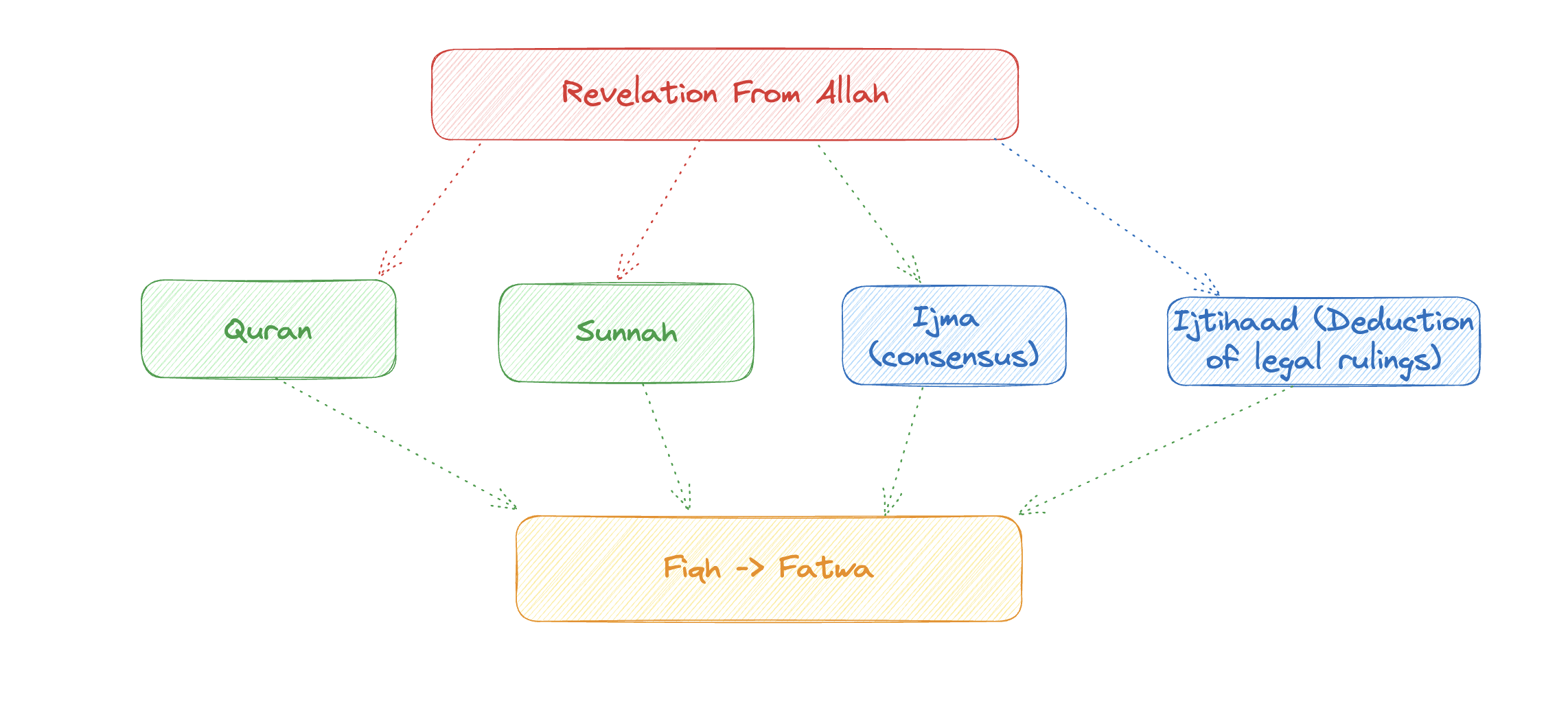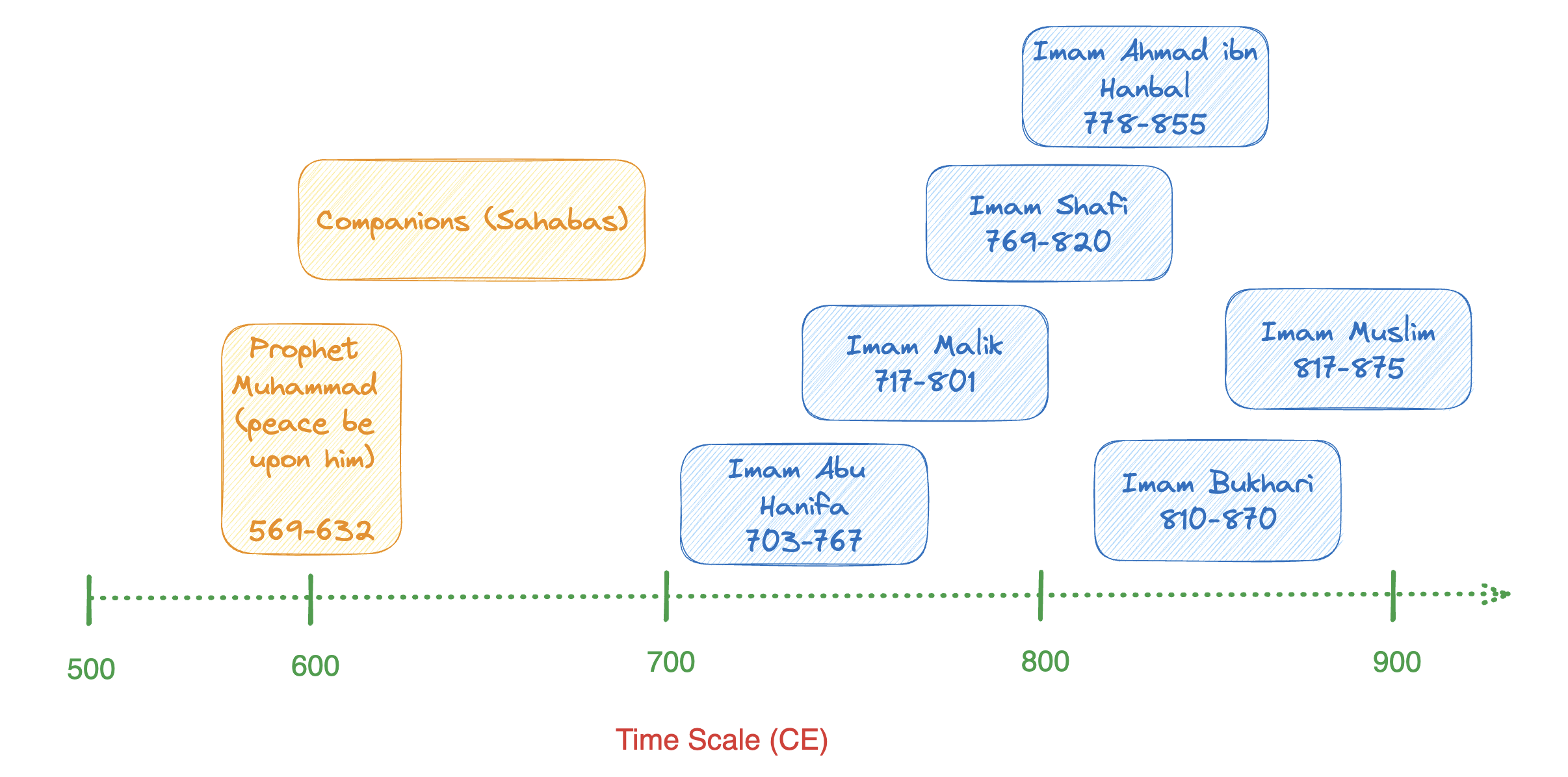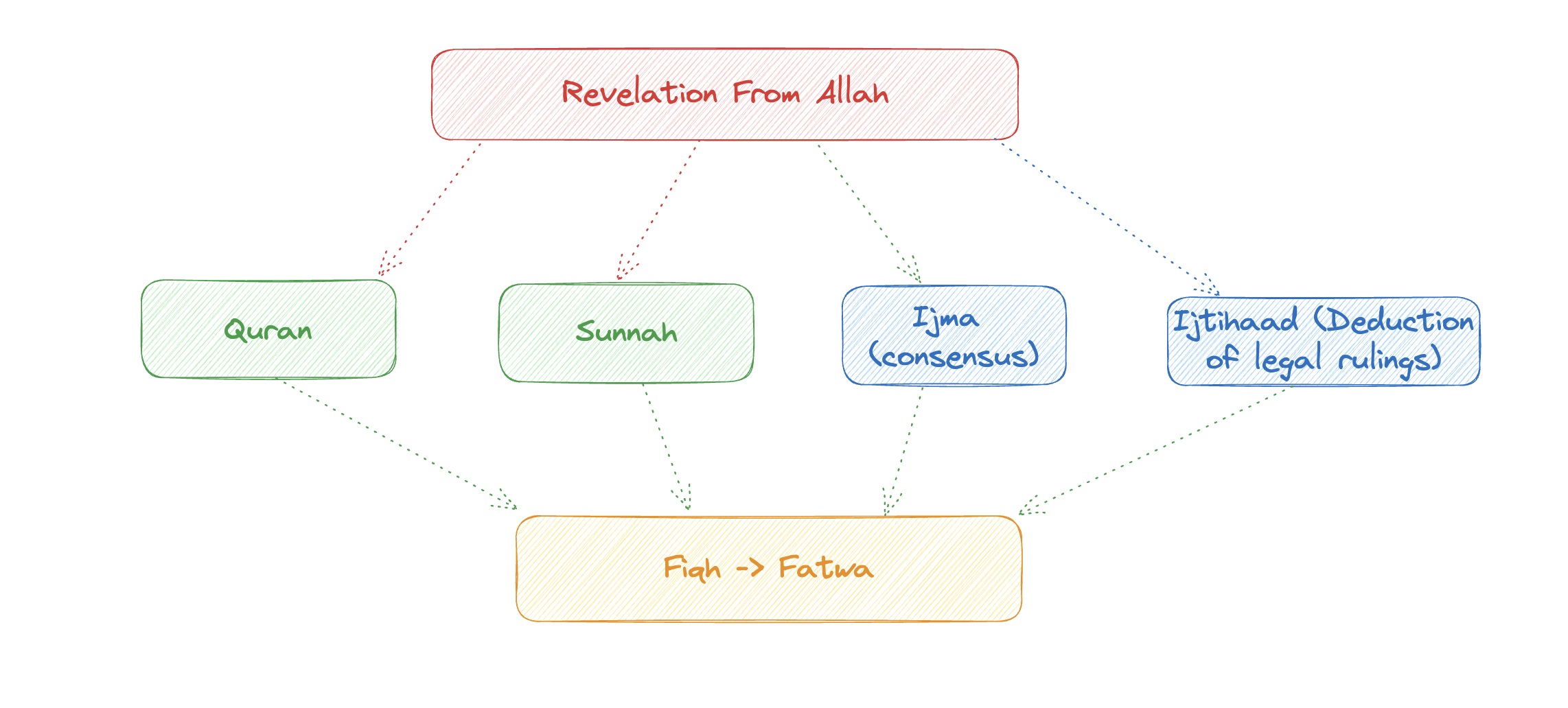
In the Name of Allah, The Most Gracious, The Most Merciful…
Have you ever come across a fatwa – a religious ruling on a specific Islamic matter – and thought, "Hold up, how do scholars even come up with these answers?” Many of us have encountered various religious verdicts on fiqh related issues, from the seemingly simple to the deeply complex. However, the journey from question to answer, from uncertainty to clarity, is a fascinating exploration that often remains veiled to many.
It's a curious scenario: we encounter these rulings, we follow them, but how often do we take the time to understand and contemplate on how a scholar reached this decision? The field of fiqh, or Islamic jurisprudence, is often depicted as a complex tapestry comprising various opinions, schools of thought, and legal verdicts, which leaves many of us feeling perplexed and discouraged from exploring it in detail.
Our attachment to a particular school of thought is often based on cultural or family traditions. For any specific issue, we follow a specific school of thought - be it Shafi'i, Maliki, Hanafi, or Hanbali - and find ourselves trapped in a complex web of conflicting answers. But if we take a step back and go back to the time before these scholars, how did people understand fiqh issues back then?
So, the goal of these blog posts is to simplify these complexities and explore the topic of usul al-fiqh in a clear and interesting way. It's not about following a specific madhab, but rather understanding the fundamental principles in Hadith and how they are applied in different situations.
Note: If you're coming across terms like Ijithaad, Qiyaas, Rai, or different types of hadith (ahaad, mutawaatir, etc.) for the first time in this article, it might be confusing. Don't get discouraged; this post is an introduction to the topic, aiming to provide a basic understanding of the subject's history, and the evolution of fiqh over time. InshaAllah, we will delve into each term more thoroughly in the upcoming posts.
Introduction
There's a profound truth in the saying, 'Without a thorough understanding of the history of any subject, it remains an enigma, with its roots unexplored and its true essence lost to the sands of time.' Exploring the history and evolution of Islamic subjects is valuable. It helps us see how these fields developed, avoiding the idea that they are entirely new inventions.
The foundational principles of Islamic jurisprudence (usul al fiqh) and various other branches of knowledge within Islam, such as mustalah hadith etc, find their intrinsic roots in the divine revelation (Quran and Sunnah). While the terminology and categorization have evolved over time, these branches remained fundamentally integral elements of the original divine revelation.
It is important to understand that these sciences weren't introduced by scholars; instead, they originate from the Quran and Sunnah, through the teachings of our Prophet (ﷺ). The evolution of terminology has merely adapted to emerging needs and circumstances.
For example, in the era of our Prophet (ﷺ), all legal rulings of the Shariah were resolved by directly consulting our Prophet (ﷺ), forming the foundational principles (usul) for Islamic jurisprudence (fiqh). Consequently, in that era, the science of usul al-fiqh and fiqh naturally intertwined without requiring explicit labels. This understanding is crucial to avoid confusion and acknowledge that these sciences are not new inventions but had existed previously, as mentioned before.
Definition
The definiton of Usul ul-Fiqh is understood in two ways: Firstly with regards to the first component “Usul” and the second “Fiqh”.
“Usul” is the plural of the word “asl” and it means whatever can have something else built upon it, and from that we have the “asl” (foundation) of a wall which is in essence its base; likewise, the foundation of a tree which has many branches sprotuing form it. As Allah, The Most High says:
See you not how Allâh sets forth a parable? A goodly word as a goodly tree, whose root is firmly fixed, and its branches (reach) to the sky (i.e. very high)). (Quran, 14:24)
“Fiqh” linguistically means understanding, as is the case in the statement of Allah, The Most High:
وَٱحْلُلْ عُقْدَةًۭ مِّن لِّسَانِى يَفْقَهُوا۟ قَوْلِى
And loose the knot (the defect) from my tongue, (i.e. remove the incorrectness from my speech). "That they understand my speech. [That occurred as a result of a brand of fire which Mûsâ (Moses) put in his mouth when he was an infant]. (Tafsir At-Tabarî). (Quran, 20:27-28)
Hence, Usul al-fiqh refers to the body of evidence, principles, and methods that scholars use to provide rulings to issues. Knowing it equips the student of knowledge with the skills to thoroughly examine the foundations of rulings and deduce evidence for what is permissible (halal) and impermissible (haram), and to learn how scholars analyze different sources of Islamic law to come up with legal rulings. Knowing these principles also makes it easier to understand the varying difference of opinions amongst scholars.
Simply put, only Allah has the authority to make laws. These laws are found in the Quran and the Sunnah of the Prophet (peace be upon him). Allah says in the Quran,
O you who believe! Obey Allâh and obey the Messenger (Muhammad صلى الله عليه وسلم), and those of you (Muslims) who are in authority. (And) if you differ in anything amongst yourselves, refer it to Allâh and His Messenger (صلى الله عليه وسلم), if you believe in Allâh and in the Last Day. That is better and more suitable for final determination. [Quran,4: 59]
The Evolution Of Usul al-Fiqh

During the time of our Prophet (ﷺ), all legal rulings of the Shariah were derived from the Quran and Sunnah (by consulting him (ﷺ) directly in all matters), leading to the foundation of usul al fiqh for that era.. The Sahabah were the foremost in faithfully following our Prophet (ﷺ). They learned and understood the Quran directly from him, and readily grasped the rulings and wisdom behind the legislations because it was revealed to them during their lifetime and in specific situations. They also learned directly from our Prophet (ﷺ), clarified their doubts, and thus had a deep understanding of the context of the hadiths (our Prophet's (ﷺ) narrations).
From Ibn Umar that Allāh’s Messenger (ﷺ) said:
“Do not prevent the female servants of Allāh from praying in the Mosque.” So the son of Ibn ‘Umar said: “We will surely prevent them!” So Ibn ‘Umar became very angry and said to his son: “I narrate to you from Allāh’s Messenger (salallāhu ‘alaihi wassallam) and you say: ‘We will surely prevent them?!’” (Muslim 135,442; Ahmad 2/76)
They were eyewitnesses to the deeds of our Prophet (ﷺ) and would accurately convey what they had seen to others. They would listen to the Prophet giving fatawa on various matters and would turn to him for resolution in disputes, and he would issue judgments. Whenever there was any confusion among the companions regarding a matter, he would address it, whether it pertained to interpersonal relationships, personal conduct, or political affairs. An example of this is the following hadith,
Narrated Jabir: We set out in the army of Al-Khabt and Abu Ubaida was the commander of the troops. We were struck with severe hunger and the sea threw out a dead fish the like of which we had never seen, and it was called Al-`Anbar. We ate of it for half a month. Abu Ubaida took (and fixed) one of its bones and a rider passed underneath it (without touching it). (Jabir added: ) Abu 'Ubaida said (to us), "Eat (of that fish)." When we arrived at Medina, we informed the Prophet (ﷺ) about that, and he said, "Eat, for it is food Allah has brought out for you, and feed us if you have some of it." So some of them gave him (of that fish) and he ate it. Sahih al-Bukhari 4362
They witnessed all these situations and understood the context in which they took place. Therefore, the wisdom and purpose of the Prophet's judgement were not hidden from them.
They also observed how the Prophet paid attention to the behavior of his sahaba and others. If he praised someone, they knew that person's action had been commendable. Conversely, if he criticized someone, they understood that there had been a flaw in the person's action.
Narrated Abu Sa'id al-Khudri (RAA): Two men set out on a journey and when the time of Salat (prayer) came they had no water. They performed Tayammum with clean earth and prayed. Later on they found water within the time of the prayer. One of them repeated his prayer with ablution but the other did not repeat. Then they came to Allah's Messenger (ﷺ), and related the matter to him. Addressing himself to the one who did not repeat, he said, "You followed the Sunnah and your (first) prayer was enough for you." [9] He said to the one who performed ablution and repeated: "For you there is a double reward. [Reported by Abu Dawud and An-Nasa'i]
After the death of our Prophet, the companions spread out to different parts of the world. Subsequently, the post-Prophet eras can be categorized into three distinct generations:
- The Generation of Witnesses (Listeners or Eye Witnesses): This marked the era of the Companions of the Prophet (ﷺ), individuals who directly experienced, observed, and lived alongside him. They witnessed the revelation and application of the Qur’an and Sunnah. Moreover, they witnessed how the Prophet addressed situations not explicitly covered by divine revelation. Having meticulously transcribed the entire Qur’an, many Companions undertook the responsibility of disseminating their knowledge throughout the Ummah after our Prophet's death. This period extended roughly until the conclusion of the first century after the Hijrah.
- The Generation of Collectors: This denoted the period of the students of the Prophet's companions. They received knowledge from the Companions who had directly learned from the Prophet (ﷺ). In the form of written records, they compiled the teachings passed down by the Companions. This generation is known as the Taba'een, the followers of the Companions of the Prophet.
- The Generation of Usul Al-Fiqh- Jurists: This phase corresponds to the Successors, or Followers, of the Followers of the Companions, known as the Atba at-Taba'een. During this era, a more systematic and structured approach to analyzing Islamic law emerged. This methodology was based on the teachings transmitted from the Companions to their followers. Fiqh, by definition, necessitates a foundation in principles (usul) and evidence (adillah), giving rise to Usul al-Fiqh. Although earlier jurists employed well-established principles and methodologies to guide their juristic reasoning (ijtihad), the first writing and articulation of Usul al-Fiqh as an independent science was done by Imam Shafi’i.
Let’s try and understand how the study usul al-fiqh evolved through these three generations.
Usul ul-Fiqh of the Companions (The Generation of Witnesses)

Abdullah bin Masood said: “Whoever is presented with an issue which needs a religious verdict or ruling; then let him give his verdict with what is in the Book of Allah (Quran) and if an issue presents itself which is not mentioned in the Quran, then let him give his verdict with what the Prophet Muhammad (ﷺ) judged in the issue. If an issue presents itself which is not mentioned in the Quran nor did the Prophet Muhammad (ﷺ) pass judgment in the issue than let him give his verdict in agreement with what the righteous people judged (Ijmaa). If an issue presents itself which is not mentioned in the Quran, nor did the Prophet Muhammad clarify it, nor did the righteous people make a judgment in the issue, then let him exert his ‘ijtihaad’ in the issue. (Sunan an-Nasa'i 5397, a similar hadith is reported by Umar (Sunan Ad-Daramee 1/55) and Abu Bakr (Sunan al Kubra by al Bayhaqi 10/196, #20341)).
The usul ul-fiqh of the sahabas was based on the following four foundations:
- The Book (i.e. the Qur’an)
- The Sunnah
- ‘Ijmaa’ (Consensus)
- Ijtihaad (Deduction of legal rulings)
In upcoming blog posts, we'll explore these terms in more detail, so if you find it a bit complex now, do not worry.
But to give some clarity on what the term Sunnah means, it is the statements of our Prophet (ﷺ), his actions, and his approvals. As for his statements, then the matter is clear. As for his (ﷺ) actions, then the origin is that they are recommended. However, depending on the context, it can change towards an obligation or something specific to him (ﷺ). The exception to this are the actions which it is known he (ﷺ) did not perform due to the Legislation, such as the affairs which he did coincidently and not intending them in and of themselves. In this case, such actions are permissible. The origin is that he (ﷺ) is a role model for the Ummah in all rulings, except what is made specific for him by way of evidence. His (ﷺ) approvals of something indicate its permissibility except due to an evidence [that proves otherwise]. (The Finest Selection of Usul ul-Fiqh by Abdurrahman bin Naasir as-Sa’di)
After our Prophet's death, the companions spread out to different parts of the world, handling diverse issues of people in their region based on their understanding of the Quran and Sunnah. Legal rulings emerged through consultative legislation, involving individual and collective ijithaad to resolve issues within the framework of the Sunnah. What we mean by the term "consultative legislation" is that the companions of our Prophet (ﷺ), who were knowledgeable about the Quran and Sunnah, also engaged in discussions and consultations to arrive at legal judgments. This consultative approach ensured that legal decisions were not arbitrary but based on the collective wisdom and knowledge of the companions.
Hence during this era, the necessity for developing the science of usul al-fiqh explicitly was minimal, as it coexisted with Fiqh. These principles were already in use by the sahabas, forming the basis for later generations.
Usul ul-Fiqh of the Taba'een (The Generation of Collectors)

The Taba'een followed methodology of Sahabah. And during this era, various schools of thought emerged, and each associated with renowned scholars who had their own distinct opinions and followers. This graph organizes the information by location and provides a clear overview of the famous jurists from each region.
The famous Seven Fuqaha of Madinah
- Sa'id bin al-Musayyib
- Urwah bin Az-Zubayr ibn al Awwam
- Qasim bin Muhammad ibn Abi Bakr
- Ubaydullah bin Abdillah ibn Utbah ibn Masood
- Kharajah bin Zaid bin Thabit
- Sulayman bin Yassar
- Ikhtilaaf on 7th (Abu Salama bin Abdur Rahman bin Awf, Salim bin 'Abdullah bin 'Umar, Abu Bakr bin Abd ur-Rahman bin al-Harith)
The famous Fuqaha of Makkah
- Ataa bin Abee Rabah
- Mujahid bin Jabar
- Amr bin Deenar
- Ikrimah
The famous Fuqaha of Basrah
- Hasan al-Basari
- Muhammad bin Sireen
The famous Fuqaha of Kufa (present day Iraq)
- Alqama bin Qais
- Masrooq
- Shuraih Qadhi
- Shabi
- Said bin Jubair
- Ibrahim an-nakhaee
The famous Fuqaha of Yemen
- Tawoos bin kaysan
- Wahb bin Munabbih
These are just the well-known ones, each having their own schools of thought, students, and opinions. In books such as Sunan Sa'eed ibn Mansur, Musannaf ibn Abi Shaiba, or Musannaf ibn Abdul Razzaq al-Sana'ani, a plethora of opinions on specific issues can be found. These books contain viewpoints from scholars like Ataa Ibn Abee Rabah, Mujahid, Sa'eed ibn Musayyib, Ibrahim An-Nakhaee, and Hasan al-basari.
Most of these scholars adhered to the Quran, Sunnah, and Ijma in deriving their rulings. If explicit guidance was unavailable, they patiently waited for any narration from companions or other Taba'een. In Iraq, where hadiths were fewer compared to Madinah and Mecca, scholars like Ibrahim An-Nakhaee put in efforts to derive rulings from the Quran, apply qiyas, and resolve issues.
In modern times, scholars are compiling separate books focusing on specific figures. For example, there are encyclopedias dedicated to the fiqh of Aisha radiallahu anhu, including all her verdicts in a separate book. They gather this information from various sources, like the book of Bayhaqi, Ma'rifat al-Sunan al-Asar, where they collect and document the fiqh of Mujahid, Ataa Ibn Abee Rabah, Sa'eed ibn Musayyib, Musannaf Ibn Abee Shaybah, Sunan Saeed bin Mansoor, Musannaf Abdur Razzaq and others.
Usul ul-Fiqh of the Atba at-Taba'een (The Generation of Usul Al-Fiqh - Jurists)
After the era of the Taba'een, the scholars were divided into two main groups or streams, each with its own methodology for deriving rulings. The first was the methodology of Ahlul Hadith, and the second was the methodology of Ahlul Rai. Ibn Khaldun, a renowned scholar famous for his Muqaddima states in his book:
”The Fiqh became divided into two main streams:
- The Tareeqah (method) of Ahlur Rai wal Qiyas (the followers of Rai and Qiyas). They were the inhabitants of Iraq.
- The Tareeqah of Ahlul Hadith. They were the inhabitants of Hijaz (Makkah-Madinah).
Due to the presence of fewer ahadith in Iraq, scholars there devoted themselves more to Qiyas, acquiring expertise in this method. Consequently, they have been classified as Ahlur Rai, meaning the followers of Rai”* (as mentioned by Abdur Rahman Ibnu Khaldoon in Tareekh Muqaddamah)
Abu Bakr Al-Shahristani wrote a comprehensive book titled Al-Milal Wal-Nihal, covering various sects, methodologies, and the entire history of Islam. He categorized Mujtahidun into two groups: Ashabul Hadith and Ashabul Rai. To quote from his book:
"Then the Mujtahidoon from the Aimmah of Ummah are restrained into two categories, and there is no third: Ashabul Hadith and Ashabur-Rai.
Ashabul Hadith are the people of Hijaz, the companions of Malik bin Anas, the companions of Muhammad bin Idris Ash-Shafiee, the companions of Sufyan Ath-Thawri, the companions of Ahmad bin Hanbal, the companions of Dawud bin Ali ibn Muhammad Al-Asbahani. They were named Ashabul Hadith because of their meticulous care to obtain Ahadith, transmit the narrations, and build the Ahkam on clear texts. They do not turn to Qiyas Al-Jali or Khafi when they find a narration…
Ashabur-Rai are the people of Iraq, the companions of Abu Hanifah An-Numan bin Thabit. Among his companions are Muhammad bin Al-Hassan, Abu Yusuf Yaqub bin Muhammad Al-Qadhi, Zufar bin Huzayl, Al-Hassan bin Zyad Al-Lului, Ibn Sama’ah, Afiyah Al-Qadhi, Abu Mutee Al-Balkhi, and Bishr Al-Marisi. They were named Ashabur-Rai because of their meticulous care to obtain a form of Qiyas and the meaning extracted from rulings, basing their formulations on them. Sometimes they favor the Qiyas Al-Jali over the Ahad narrations" (Al-Milal wan Nihal 1/206)
To summarise the difference,
| Ashabul Hadith | Ashabur-Rai | |
|---|---|---|
| Region | People of Hijaz (Western Arabia) | People of Iraq |
| Companions | Malik bin Anas, Muhammad bin Idris Ash-Shafiee, Sufyan Ath-Thawri, Ahmad bin Hanbal, Dawud bin Ali ibn Muhammad Al-Asbahani | Abu Hanifah An-Numan bin Thabit, Muhammad bin Al-Hassan, Abu Yusuf Yaqub bin Muhammad Al-Qadhi, Zufar bin Huzayl, Al-Hassan bin Zyad Al-Lului, Ibn Sama’ah, Afiyah Al-Qadhi, Abu Mutee Al-Balkhi, Bishr Al-Marisi |
| Characteristics | Meticulous care to obtain Ahadith, transmit narrations, and build Ahkam on clear texts. Do not turn to Qiyas Al-Jali or Khafi when finding a narration. | Meticulous care to obtain a form of Qiyas and the meaning extracted from rulings. Formulations based on Qiyas. Sometimes favor Qiyas Al-Jali over the Ahad narrations. |
| Categorization | Scholars of Hijaz, Ashabul Hadith | Scholars of Iraq, Ashabur-Rai |
Interestingly, the four madhahib we know of are not the only ones that existed. Surprising, right? Here are a list of Madhahib al-Faqhiyyah from the time of Atba at-Taba'een
- Madhab Imam Abu Hanifa
- Madhab Imam Malik
- Madhab Imam Shafi
- Madhab Imam Ahmad
- Madhab Imam Sufyan bin Uyaiyah
- Madhab Imam Sufyan al-Thawri
- Madhab Imam al-Awzai
- Madhab Imam Layth bin Saad
- Madhab of Imam Ishaq bin Rahaway
- Madhab Imam Dawood al-Dhahiri
- Madhab Ibn Khuzaymah
- Madhab Ibn Jareer al-Tabari
- Madhab Abu Thawr
Tareekh Fiqh al-Islami p81-82, Al-Meezan Sharani (1/152), Alam al-Muwaqqieen 3/178)
Conclusion
This was a brief attempt to explore how usul al-fiqh evolved over time. But hold on! We're not finished with the history yet! InshaAllah, in the next blog, we'll delve into understanding the differences between the methodology of Ahlul hadith and Ahlul Rai, exploring why these differences emerged.
After that inshaAllah, we'll start understanding the actual subject of usul al-fiqh, breaking down the technical details of each term you've encountered, and providing plenty of examples to make the subject easier to understand. Keep an eye out for more detailed explanations. If you have any questions, feel free to reach out!
If you like our content, please subscribe to our blog! And Follow us on Instagram or Telegram to stay up to date!





